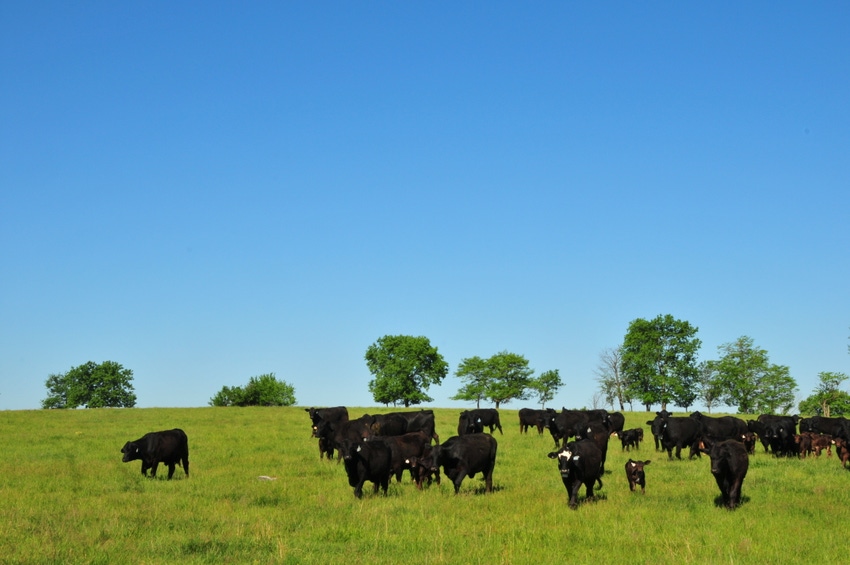If converting existing stand of K-31 fescue to novel-endophyte fescue, measures need to be taken to ensure complete K-31 elimination.
February 16, 2022

Ernest Newton Fergus, a University of Kentucky forage specialist in the 1930s and 1940s, did the livestock industry a great favor when he propagated Kentucky 31 fescue, says University of Missouri Extension agronomist Tim Schnakenberg.
"Fescue in general is palatable with outstanding quality at early growth," Schnakenberg says. "It tolerates abusive grazing and survives drought, diseases, insects and cold weather. Fescue provides a consistent amount of fall and winter grazing very cheaply. The seed is readily available and easy to establish."
But Kentucky 31 fescue has a major downside: It hosts a toxic endophyte fungus that can affect livestock performance. "K-31 revolutionized the cattle industry in Missouri," Schnakenberg says. "But in some cases, maybe it's time to make some changes that will bring greater profitability for livestock operations."
Most agronomists are not going to promote replacing K-31 fescue completely, because that is not going to happen, he says. "However, livestock producers who learn how to use it and/or supplement with other forage options are ahead of the curve on dealing with the drawbacks."
Novel-endophyte fescues, which host a nontoxic version of the fungus, can significantly improve animal performance and farm profitability, he says. "Research out of Arkansas found significant results in cow reproduction rates by converting just 25% of a farm operation to novels coupled with strategic management."
Another good reason to renovate a fescue pasture is when grassy weeds dominate a pasture or paddock. "There are many pasture and hayfield stands that once were strong fescue fields but aren't anywhere close to that anymore," Schnakenberg says. "In most cases, there are no selective herbicides to eliminate or reduce less desirable species in a field. Complete renovation may be the only solution if a purer stand is desired."
Fescue seed can stay viable in the ground for at least 12 months, so if you intend to convert an existing stand of K-31 fescue to novel-endophyte fescue, Schnakenberg strongly recommends taking measures to ensure complete K-31 elimination.
"It is imperative to prevent seed from the old K-31 crop to be made the year of establishment," he says. "In addition, it is important to understand that one application of glyphosate will not kill all old K-31 crowns completely. If K-31 survives in the new novel stand, it can dominate the novel over time, partly because the cattle typically prefer to graze the novel harder than the K-31."
Schnakenberg recommends taking steps to fully eliminate K-31 crowns and planting at the best time of year. "In most cases, a late summer or early fall seeding is the most ideal," he says. "This is usually during September, unless conditions are too dry. We generally will not recommend a novel seeding in the spring, but preparation must begin in the spring."
The most common preparation method is a "spray-smother-spray" approach that involves killing the old fescue in the spring with heavy rates of glyphosate, planting a summer interim/smother crop and making a second spray of glyphosate in the fall before novel fescue planting.
"To further ensure that no K-31 survives, producers could consider beginning the year in advance by using both a cool-season interim crop over the winter and a warm-season interim crop in the summer," he says. "Cool-season smoother crops may be cereal rye, triticale or wheat. Warm-season options may be sorghum-Sudangrass, millet, teff or corn for silage or grain."
This method is the most expensive and time-consuming approach. Another method is a "spray-wait-spray" approach, Schnakenberg says. "This involves not letting the spring growth of K-31 go to seed, then spraying it out with a stout rate of glyphosate later in the spring, perhaps even after some spring grazing or haying. Instead of planting a smother crop, the field is left fallow for the summer. Then, a couple weeks or less before later summer/fall planting, do a second glyphosate spray. Missouri research has found that this method is also effective in eliminating any K-31 resurgence in the new stand."
Many will see the price of seed and think it's just not worth it, he says. "But ag economists out of Missouri and North Carolina have studied this issue closely. They have concluded that if you follow the spray-smother-spray steps, it might take up to five years to get a full payback from the process in improved animal performance. If fields already need renovation and are unproductive, that amounts to about a three-year payoff. If the plan is to only convert up to 25% of the farm to novels, the payoff can take about two years."
There are many factors for producers to consider when deciding if converting to novel fescues is worth it. "Decades of research data have shown that the fescue endophyte significantly reduces on-farm profit in the cattle business," Schnakenberg says. "Unfortunately, many producers do not recognize the quiet siphoning off of profits that happens as a result of the endophyte."
Using novel fescue, combined with other measures, can be a huge benefit for a farm operation, he says. "There are farms with weaning weight data on calves that show major improvements in gain after cattle started grazing novel fescues."
Source: University of Missouri Extension, which is solely responsible for the information provided, and wholly owns the information. Informa Business Media and all its subsidiaries are not responsible for any of the content contained in this information asset.
You May Also Like



